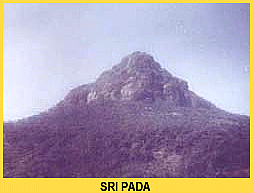

mailto: payer@hdm-stuttgart.de
Zitierweise / cite as:
Mahanama <6. Jhdt n. Chr.>: Mahavamsa : die große Chronik Sri Lankas / übersetzt und erläutert von Alois Payer. -- 16. Kapitel 16: Entgegennahme des Cetiyaberg-Klosters. -- Fassung vom 2006-06-01. -- URL: http://www.payer.de/mahavamsa/chronik16.htm. -- [Stichwort].
Erstmals publiziert: 2001-06-25
Überarbeitungen: 2006-06-01 [Ergänzungen]; 2006-05-19 [Ergänzungen]; 2006-04-21 [Umstellung auf Unicode!]; 2006-03-02 [Einfügung des Palitexts]
Anlass: Lehrveranstaltung, Universität Tübingen, Sommersemester 2001
©opyright: Dieser Text steht der Allgemeinheit zur Verfügung. Eine Verwertung in Publikationen, die über übliche Zitate hinausgeht, bedarf der ausdrücklichen Genehmigung des Übersetzers.
Dieser Text ist Teil der Abteilung Buddhismus von Tüpfli's Global Village Library
Pālitext: http://www.tipitaka.org/tipitaka/e0703n/e0703n-frm.html.-- Zugriff am 2001-06-06
Falls Sie die diakritischen Zeichen nicht dargestellt bekommen, installieren Sie eine Schrift mit Diakritika wie z.B. Tahoma.
Die Zahlreichen Zitate aus Malalasekera, G. P. <1899 - 1973>: Dictionary of Pāli proper names. -- Nachdruck der Ausgabe 1938. -- London : Pali Text Society, 1974. -- 2 vol. -- 1163, 1370 S. -- ISBN 0860132692. sind ein Tribut an dieses großartige Werk. Das Gesamtwerk ist online zugänglich unter: http://www.palikanon.com/english/pali_names/dic_idx.html. -- Zugriff am 2006-05-08.
Soḷasama pariccheda
Cetiyapabbatavihāra paṭiggahako
Alle Verse mit Ausnahme des Schlussverses sind im Versmaß vatta = siloka = Śloka abgefasst.
Das metrische Schema ist:
̽ ̽ ̽ ̽ ˘ˉˉˉ
̽ ̽ ̽ ̽ ˘ˉ˘ˉ
̽ ̽ ̽ ̽ ˘ˉˉˉ
̽ ̽ ̽ ̽ ˘ˉ˘ˉ
Ausführlich zu Vatta im Pāli siehe:
Warder, A. K. (Anthony Kennedy) <1924 - >: Pali metre : a contribution to the history of Indian literature. -- London : Luzac, 1967. -- XIII, 252 S. -- S. 172 - 201.
1. Pure caritvā piṇḍāya,
karitvā
janasaṅgahaṃ;
rājagehamhi bhuñjanto,
kārento rājasaṅgahaṃ.
2. Chabbīsadivase thero,
Mahāmeghavane
vasī;
1./2a. Der Thera [Mahinda] ging in der Stadt [Anurādhapura] auf Almosengang, dann erwies er dem Volk [durch eine Predigt] eine Wohltat, speiste im Königspalast, erwies dem König eine Wohltat. So weilte er 26 Tage im Mahāmegha-Hain1.
Kommentar:
1 Mahāmegha-Hain
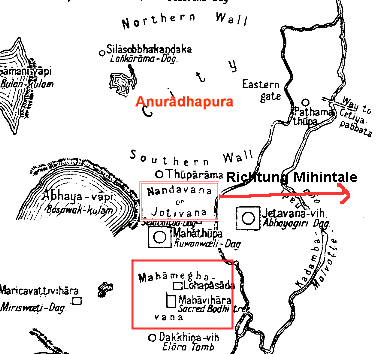
Abb.: Lage des Mahāmeghavana
āsaḷhasukkapakkhassa,
terase divase pana.
3. Rājagehamhi bhuñjitvā,
mahārañño
mahāmati;
mahāppamādasuttantaṃ,
desayitvā tato va so.
4. Vihārakaraṇaṃ icchaṃ,
tattha Cetiyapabbate;
nikkhamma purimadvārā,
agā Cetiyapabbataṃ.
2b./3./4. Als der Weise aber am 13. Tage der hellen Hälfte des Monats Âsālha1 [4. Monat, entspricht Mai/Juni bzw. Juni-Juli] im Königspalst gespeist hatte, verkündete er dem großen König die große Lehrrede von der Nicht-Nachlässigkeit2. Dann ging er, da er die Errichtung eines Klosters auf dem Cetiya-Berg3 [Mihintale] wünschte, durch das Osttor zum Cetiya-Berg.
Kommentar:
1 Âsālha: 4. indischer Monat, entspricht Mai/Juni bzw. Juni-Juli
2 Im Saṃyuttanikāya und im Aṅguttaranikāya gibt es mehrere Lehrreden von der Nicht-Nachlässigkeit (appamāda-sutta):
- Samyuttanikāya I, 86f.
- Samyuttanikāya II, 132
- Samyuttanikāya V, 30ff.
- Anguttaranikāya II, 119f.
- Anguttaranikāya III, 364
- Anguttaranikāya IV, 27f.
- Anguttaranikāya V, 21f.
- Samyuttanikāya V, 33
Im fünften Teil (Mahāvagga) des Saṃyuttanikāya gibt es auch einige Kapitel die appamādavagga genannt werden (Saṃyuttanikāya V, 41 - 45, 191, 135ff., 240ff., 245, 250ff, 291, 308)
Eine Identifizierung der hier gemeinten Lehrrede ist mir nicht möglich.
3 Cetiya-Berg: Mihintale
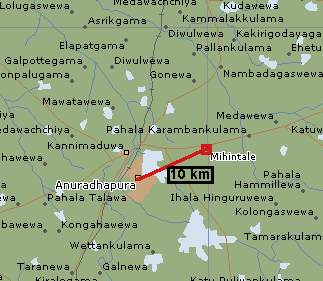
Abb.: Lage des Cetiya-Berges (Mihintale) (©MS Encarta)
"Cetiyapabbata Also called Cetiyagiri. The later name of the Missaka mountain given on account of its many shrines. Devānampiyatissa built a vihāra there - the second vihāra in Ceylon - for Mahinda and those ordained under him (Mhv.xvi.12-17). The relics, obtained by Sumanasāmanera from Asoka and from Sakka, were deposited there until they were needed. According to the Mahāvamsa (Mhv.xxii.23ff) this fact was the occasion for the name. One of the eight saplings of the Sacred Bodhi-tree at Anurādhapura was planted in the drama on Cetiyagiri (Mhv.xix.62). Mahinda spent the last years of his life on Cetiyagiri and died there, and there his relics were enshrined (Mhv.xx.32, 45). Near the mountain was the village of Dvāramandala (Mhv.xxiii.23). Kutakannatissa built an uposatha-hall on the mountain and planted a Bodhi-tree, while Bhāti-kābhaya supplied food daily to one thousand monks dwelling there (Mhv.xxxiv.30f, 64), and Lañjakatissa had the vihāra paved at a cost of one hundred thousand (Mhv.xxxiii.25). Mahādāthikamahānāga made four gateways and a road round the mountain, and held the Giribhandapūjā with great pomp and ceremony; it is said that in order that the people might approach the mountain with clean feet he spread carpets right up to it from the Kadamba River (Mhv.xxxiv.75ff). Kanirajānutissa had sixty monks of Cetiyapabbata put to death as traitors by flinging them into the cave called Kanira (Mhv.xxxv.11). Vasabha provided four thousand lamps to be lighted on Cetiyagiri (Mhv.xxxv.80), while Jetthatissa gave to the vihāra the income derived from the Kālamattika Tank. (Mhv.xxxvi.130; see also Dpv.xv.69; xvii.90; xix.13, and Sp.i.82ff).
In the time of Kakusandha, Cetiyagiri was known as Devakūta, in that of Konāgamana as Suvannakūta, and in that of Kassapa as Subhakūta (Sp.i.86f). The Dhammarucikas once occupied the Ambatthalavihāra on Cetiyapabbata, it having been given to them by Dhātusena (Cv.xxxviii.75). Aggabodhi supplied a permanent supply of water for the bathing-tank called Nāgasondi, on the top of Cetiyagiri (Cv.xlii.28; see Cv. Trs.i.68, n.8), while Aggabodhi III. gave to the vihāra the village of Ambillapadara (Cv.xliv.122). Aggabodhi V. restored the ruined buildings of Cetiyapabbata at a cost of one hundred and twenty thousand pieces (Cv.xlviii.7), while the queen of Udaya I, built there the Kanthakacetiya, and her husband decorated the mountain with brightly coloured flags and streamers (Cv.xlix.23, 27). Sena I, gave to the monastery the income from the Kānavāpi (Cv.l.72), and Sena II. Provided a hospital for the use of the monks there (Cv.li.73). Kassapa VI. built the Hadayunha Parivena and gifted it to the Dhammarucikas (Cv.lii.18). Parakkamabāhu I restored all the old buildings which had been destroyed and built sixty-four thūpas (Cv.lxxviii.108).
The Commentaries relate several anecdotes connected with Cetiyapabbata. Maliyadeva Thera recited there the Chachakka Sutta, and sixty listening bhikkhus became arahants (MA.ii.1064). Lomasanāga Theca lived in the Padhānaghara in the Piyanguguhā there and overcame the cold he felt by meditating on the Lokantarikaniraya (MA.i.65). Cetiyapabbata was the residence of Kālabuddharakkhita, and King Saddhātissa spent some time there (MA.i.469f. See also Vsm.20, 64; DhSA.194, 200; AA.i.44). At the time that Fa Hsien came to Ceylon there were two thousand monks in Cetiyagiri, including a monk of great fame, called Dharmagupta (Giles: p.72)."
[Quelle: Malalasekera, G. P. <1899 - 1973>: Dictionary of Pāli proper names. -- Nachdruck der Ausgabe 1938. -- London : Pali Text Society, 1974. -- 2 vol. -- 1163, 1370 S. -- ISBN 0860132692. -- s. v.]
"Missakapabbata A mountain near Anurādhapura, the present Mihintale. It was while hunting the elk on this mountain that Devānampiyatissa met Mahinda who had come with his companions to convert the Island to Buddhism. It was on Silākūta, the northern peak of the mountain, that Mahinda alighted after his journey through the air from India, while the conversation between him and the king took place in Ambatthala, the small tableland below the peak (Mhv.xiii.14, 20; xiv.2; Dpv.xii.28, 37ff).
The mountain later came to be called Cetiyagiri (q.v.). Mhv.xvii.23; Dpv.xiv.56."
[Quelle: Malalasekera, G. P. <1899 - 1973>: Dictionary of Pāli proper names. -- Nachdruck der Ausgabe 1938. -- London : Pali Text Society, 1974. -- 2 vol. -- 1163, 1370 S. -- ISBN 0860132692. -- s. v.]
5. Theraṃ tattha gataṃ sutvā,
rathaṃ āruyha bhūpati;
deviyo dve ca ādāya,
therassānupadaṃ akā.
5. Als der König hörte, dass der Thera dorthin gegangen sei, bestieg er einen Wagen und folgte mit zwei Königinnen dem Thera.
6. Therā Nāgacatukkamhi,
nahātvā rahade
tahiṃ;
pabbatārohaṇatthāya,
aṭṭhaṃsu paṭipāṭiyā.
6. Die Thera's hatten im Nāgacatukka-See1 [wird mit Nāgapokuna, Nr 11 im Plan unten, identifiziert] gebadet und standen dort in Rangordnung, um den Berg zu besteigen.
Kommentar:
1 Nāgacatukka-See: wird mit Nāgapokuna, Nr 11 im Plan unten, identifiziert
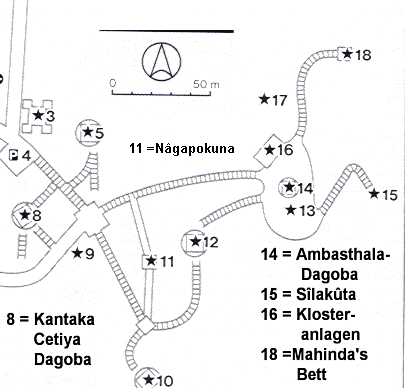
Abb.: Lageplan des Mihintale-Berges
[Vorlage der Planskizze: Krack, Rainer: Sri Lanka. -- 6., komplett aktualisierte Aufl. -- Bielefeld : Reise Know-how, 2000. -- (Reise Know-how). -- ISBN 3894168404. -- S. 432. -- {Wenn Sie HIER klicken, können Sie dieses Buch bei amazon.de bestellen}]
7. Rājā rathā tadoruyha,
sabbe
there ’bhivādiya;
uṇhe kilanto kiṃ rāja,
āgato' sī ti ahu te.
7. Der König stieg von seinem Wagen, grüßte die Thera's formgemäß. Sie fragten ihn, warum er sich in der Hitze abgeplagt habe, um zu kommen.
8. Tumhākaṃ gamanāsaṅkī,
āgatomhī ti bhāsite;
idheva vassaṃ vasituṃ,
āgatamhā ti bhāsiya.
8. Er antwortete, dass er aus Sorge über ihren Weggang gekommen sei. Der Thera antwortete, dass die hierher gegangen seien, um hier die Regenzeit zu verbringen.
9. Vassūpanāyikaṃ thero,
khandhakaṃ
khandhakovido;
kathesi rañño taṃ sutvā,
bhāgineyyo ca rājino.
10. Mahāriṭṭho mahāmacco,
pañcapaññāsabhātuhi;
saddhiṃ jeṭṭhakaniṭṭhehi,
rājānam abhito ṭhito.
11. Yācitvā tadahu ceva,
pabbajuṃ
therasantike;
pattārahattaṃ sabbe pi,
te khuragge mahāmatī.
9. - 11. Dann erklärte der Thera, der bewandert war in den Bestimmungen der Ordensregeln dem König die Bestimmungen über die Regenzeit1. Als die der Schwestersohn des Königs, der Chefberater Mahāriṭṭha2, der mit seine 55 älteren und jüngeren Brüdern um den König stand, hörte, baten sie den König um Erlaubnis und wurden noch an jenem Tag beim Thera Novizen. All diese Weisen erreichten schon beim Scheren der Haare Arhantschaft [d.h. wurden vollkommen Erlöste].
Kommentar:1 Die wichtigsten Bestimmungen über die Regenzeit für Mönche sind:
- Während drei Monaten der Regenzeit müssen Mönche an einem Ort sesshaft bleiben
- Für diese Zeit müssen sie in der Regenzeit angemessenen Behausungen wohnen, z.B. nicht unter einem Schirm oder in einer Baumhöhle
- Zu Beginn der Regenzeit müssen die Mönche einen Ort formell für ihren Aufenthalt während der Regenzeit bestimmen (adhitthāna n.). An diesem Ort müssen sie bis zur Pavārānā bleiben
- Wenn ein Mönch während der Regenzeit aus einem triftigen Grund über Nacht wegbleiben muss, dann kann er das bis zu sieben Tage machen. Bleibt er länger als sieben Tage von seinem Regenzeit-Wohnsitz weg, dann hat er die Regenzeit gebrochen.
- Bei drohender schwerer Gefahr für das leibliche oder geistliche Wohl eines Mönches, kann er die Regenzeit brechen, ohne dass es ein ordensrechtliches Vergehen ist
Siehe: Payer, Alois <1944 - >: Vinayamukha : Grundbegriffe der Ordensregeln und des Ordensrechts des Theravāda. -- Teil II. -- (Materialien zu den Grundbegriffen des Buddhismus). -- URL: http://www.payer.de/buddhgrund/vinaya02.htm
2 Mahāriṭṭha
"Mahā Ariṭṭha Nephew of Devānampiyatissa. He was the king's chief minister, and led the embassy which was sent to Asoka soon after Devānampiyatissa ascended the throne (Mhv.xi.20). Asoka conferred on him the title of Senāpati (Mhv.xi.25). It is said that he had fifty five elder and younger brothers who all joined the Order at Cetiyagiri at the end of a sermon by Mahinda on the Vassūpanāyikakhandha (Mhv.xvi.10). This was before the commencement of the rainy season, but elsewhere (Mhv.xviii.3; perhaps here we have to deal with two different traditions) it is said that Arittha was sent in the month of Assayuja - after the pavārana, when the rains were over - to Pātaliputta to fetch Sanghamittā and the Bodhi tree from the court of Asoka, and that, he agreed to go only on condition that he should join the Order on his return. The king consented, and, his mission successfully concluded, he entered the Order with five hundred others and attained arahantship (Mhv.xix.5, 12, 66). He died in the reign of Uttiya (Mhv.xx.54).
The Samantapāsādikā (Sp.i.102ff) gives an account of a recital (sangīti) held in Ceylon by Mahā Arittha. The scene was the parivena of the minister Meghavannābhaya in the Thūpārāma, where sixty eight thousand monks were assembled. A seat, facing south, was provided for Mahinda, Arittha's seat, the dhammāsana, facing north. Arittha occupied this seat at Mahinda's request, and sixty eight Mahā-theras, led by Mahinda, sat around him. Devānampiyatissa's younger brother, Mattābhaya Thera, with five hundred others, were present in order to learn the Vinaya, the king also being present. When Arittha began his recital of the Vinaya, many miracles occurred. This was on the first day of the pavārana ceremony in the month of Kattika.
Mahā Arittha's chief disciples were Tissadatta, Kālasumana and Dīghasumana (q.v.)."
[Quelle: Malalasekera, G. P. <1899 - 1973>: Dictionary of Pāli proper names. -- Nachdruck der Ausgabe 1938. -- London : Pali Text Society, 1974. -- 2 vol. -- 1163, 1370 S. -- ISBN 0860132692. -- s. v.]
12. Kantakacetiyaṭhāne,
parito tadahe va
so;
kammāni ārabhāpetvā,
leṇāni aṭṭhasaṭṭhiyo.
12. Der König ließ noch an jenem Tag die Arbeiten beginnen, um 68 Wohnhöhlen1 um den Platz des künftigen Kantakacetiya herum zu bauen.
Kommentar:
1 Wohnhöhlen:
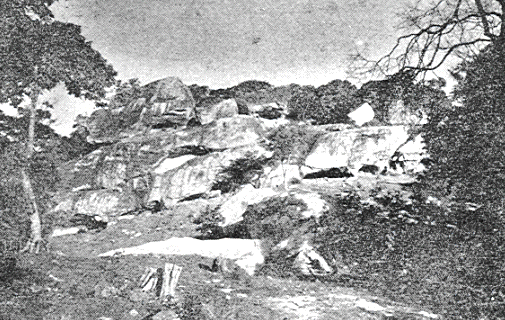
Abb.: Wohnhöhlen für Mönche aus der Zeit Mahinda's
(Foto: Ceylon
Archaeological Survey)
13. Agamāsi puraṃ rājā,
therā tattheva
te vasuṃ;
kāle piṇḍāya nagaraṃ,
pavisantānukampakā.
13. Dann ging der König in die Stadt, die Thera's aber wohnten dort. Zur rechten Zeit gingen sie aus Erbarmen in die Hauptstadt auf Almosengang.
14. Niṭṭhite leṇakammamhi,
āsaḷhipuṇṇamāsiyaṃ;
gantvā adāsi therānaṃ,
rājā vihāradakkhiṇaṃ.
14. Als die Arbeiten an den Wohnhöhlen beendet waren, kam der König am Vollmondtag des Monats Âsālha1 und gab den Thera's das Kloster als Schenkung.
Kommentar:
1 Âsālha: 4. indischer Monat, entspricht Mai/Juni bzw. Juni-Juli
15. Dvattiṃsamāḷakānañ ca,
vihārassa ca
tassa kho;
sīmaṃ sīmātigo thero,
bandhitvā tadahe va so.
15. Der Thera, der alle Grenzen überschritten hatte, bestimmte noch am gleichen Tag die ordensrechtlichen Grenzen1 des Klosters sowie von 22 Terrassen für Zeremonien (mālaka).
Kommentar:
1 Zu den Grenzen (sîmā) siehe: Exkurs 2 zu Kapitel 15: Sîmā -- URL: http://www.payer.de/mahavamsa/chronik15e2.htm
16. Tesaṃ pabbajjāpekkhānaṃ,
akāsi
upasampadaṃ;
sabbesaṃ sabbapaṭhamaṃ,
baddhe Tumbarumāḷake.
16. Dann vollzog er noch an jenem Tag auf der Tumbaru-Terrasse, die als erste von allen abgegrenzt worden war, die Mönchsordination für alle [nämlich Mahārittha und seine Brüder], die nicht mehr nur Novizen sein wollten.
17. Ete dvāsaṭṭhi arahanto,
sabbe Cetiyapabbate;
tattha vassaṃ upagantvā,
akaṃsu rājasaṅgahaṃ.
17. Diese 621 Arhants bestimmten diesen Ort zu ihrem Aufenthalt für die Regenzeit und erwiesen dem König eine Wohltat [durch eine Lehrrede].
Kommentar:
1 62: Mahinda und seine 5 Gefährten + Mahārittha + seine 55 Brüder
18. Devamanussagaṇā gaṇinaṃ taṃ,
tañ ca gaṇaṃ guṇavitthatakittiṃ;
yātam upacca ca mānayamānā,
puññacayaṃ vipulaṃ akariṃsū
ti.
18. Scharen der Götter und Menschen kamen ehrfürchtig zum Scharführer [Mahinda] und seiner, weit herum wegen ihrer Tugend berühmten Schar und häuften viel Verdienst auf.
Kommentar:
Versmaß:
Dodhaka
(11 Silben, 6.5.; Schema: bha bha bha ga ga: Dodhakam icchati bhatritayād gau: "Das Dodhaka wünscht nach drei bha zwei ga.")ˉ˘˘ˉ˘˘ˉ˘˘ˉˉ
ˉ˘˘ˉ˘˘ˉ˘˘ˉˉ
ˉ˘˘ˉ˘˘ˉ˘˘ˉˉ
ˉ˘˘ˉ˘˘ˉ˘˘ˉˉZur Metrik siehe:
Payer, Alois <1944 - >: Einführung in die Exegese von Sanskrittexten : Skript. -- Kap. 8: Die eigentliche Exegese, Teil II: Zu einzelnen Fragestellungen synchronen Verstehens. -- Anhang B: Zur Metrik von Sanskrittexten. -- URL: http://www.payer.de/exegese/exeg08b.htm
Sujanapasādasaṃvegatthāya kate
Mahāvaṃse
Cetiyapabbatavihārapaṭiggahaṇo nāma soḷasamo paricchedo.
Dies ist das sechzehnte Kapitel des Mahāvamsa, der zum Vertrauen und zur Erschütterung der guten Menschen verfasst wurde. Der Titel dieses Kapitels ist "Die Entgegennahme des Cetiyaberg-Klosters".
M = Mahāvaṃsa; EM = Extended Mahāvaṃsa; MT = Mahāvaṃsa Ṭīkā. "Chapter XVI. This chapter is an account of the arrangements made by Devānampiyatissa to enable Mahinda and his colleagues to spend the rainy season at Cetiyapabbata. It also describes the entry of the minister Mahāriṭṭha and his 55 brothers into the Order.
M. and EM. agree very closely. M. says, however, (16) that Mahinda conferred the upasampadā on Mahāriṭṭha and his colleagues at the Tumbarumālaka. EM. does not mention Tumbarumālaka at all but adds (20) that Mahinda preached the Devadūta Sutta to those that had been newly ordained and they became arahants at the conclusion of his sermon. This information is not given elsewhere."
[Quelle: G. P. Malalasekera (1899 - 1973). -- In: Extended Mahāvaṃsa / ed. by G. P. Malalasekera. -- Colombo : Times of Ceylon, 1934. -- LVIII, 380 S. -- (Aluvihāra Series ; III). -- Reprint: Oxford : Pali Text Society, 1988. -- ISBN 0-86013-285-4. -- S. XXVIIf.]
Zu Kapitel 17: Ankunft der Reliquien